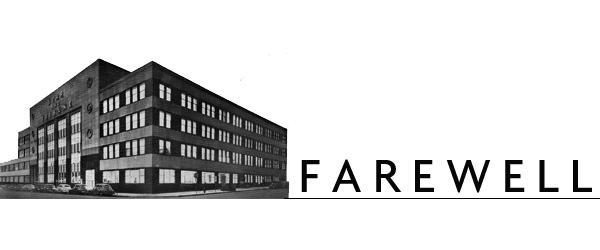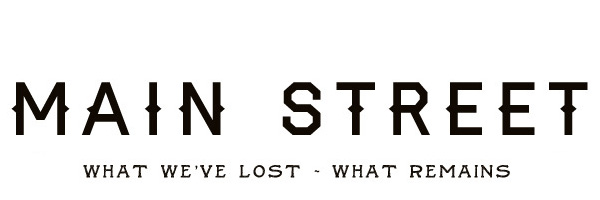 I wonder if there'll be cake. I wonder if there'll be cake.
Cake when we leave, or cake when we arrive? I'd prefer cake on the way out. For that matter, champagne. Or cheap bubbly. Something to toast the old office as we leave forever. No one seems sad that we're leaving, just harried. Worn to a frazzle. Wor-an to a fraaaazle.
Do you know where that catchphrase came from? If you do you were a 40s kid and your childhood was awesome!
Sorry. I come across that a lot on some of the . . . younger corners of the interest. A picture o a 90s game character. IF YOU REMEMBER THIS YOUR CHILDHOOD WAS AWESOME. Well, not if you recall playing the game through a smear of tears because Mom and Dad were fighting again. More like IF YOU REMEMBER THIS THEN YOU PARTICIPATED IN MASS CULTURE. The difference nowadays is that the young-person's internet culture refers back constantly to the items at the dim periphery of the millennial's experience. When I was reading a magazine aimed at 20 year olds, no one was talking about how AWESOME Tom Swift was, and if you remember Creepy Crawler machines your childhood was INCREDIBLE DUDE. But we didn't have day-care from grown-ups, either.
I know there's no comparison, none, not a jot, not a whit, between my cadre and the people who got on drab ships to shoot people in other countries, but at least we had an existential threat. It does concentrate the mind. When it was lifted in the 90s it was quite amazing, really; like living with tinnitus all your days, and then realizing one day that you weren't hearing it anymore. The culture of my formative early-adult years was alternately nihilistic and despairing, and cheerful and hedonistic. The punks were not hedonistic. They were spotty losers who made headlines because they spit at people, and could occasionally get it together long enough to play a song. The New Wave bands were more polished and intent on the usual Rock Things - fame, money, sex, and okay maybe artistic integrity somewhere in there. There were the deep thinkers who urged us to think about the Russians, and to hope that they loved their children as well, and the disco dolts who decided that viewing the struggle between capitalism and communism was just a matter of "Two Tribes," a concept that could be mocked by the post-tribe intellectuals with appropriate puppets. But through it all was nervous drumming on the arm of the chair when the top-of-the-hour news came on, because you never knew.
It seems odd that a generation that put up their periscope after 9/11 doesn't share the same vague wariness.
Anyway: worn to a frazzle. Lum said this on "Lum and Abner," the great and gentle radio sitcom that's one of the criminally forgotten pieces of 40s pop culture. I find myself saying that to myself some times, to myself. Even though I know I'm not. I live in a world where I wonder whether there might be cake. And if there isn't? I can go buy some. Cake everywhere.


Today we tour the basement, for one last time. The morgue has been emptied of its clips; I think they're going to a historical society. If not, no permanent loss; all the papers have been digitized and I'm sure OCR is underway to make them searchable. Sic transit gloria mundi:

And if Gloria Mundy was one of the ladies who clipped these things out, that would be apt. This envelope shows how it worked - the clipping was annotated with the date, then stamped on the edge to indicate its most recent update.

Every paper was cut up and arranged in envelopes - a tedious job, and in the end, all for naught. Some of the old reporters have been showing up to get their clips, and they'll pass along to someone else who'll hold history in their hands.
In a dim room previously locked, I found old schematics of the building. These are amazing:

Most intriguing is the word "Tunnel." There's nothing as mysterious as the idea of lost tunnels, sealed up eons ago. Always a chance there'll be skeletons.
It's possible this . . . was the door that led to the tunnel.

The basement has always been the last place in the building where nothing changed, the only place where remnants of the 30s and 40s can be seen. There's a locker room for the pressmen, a place to shower before you headed home. Small and narrow, the atmosphere soaked with seven decades of gym smells. (Probably just soap.) The old taps:

The inviting shower, in case you want to be naked with co-workers NO THANKS THAT'S OKAY

You can be certain that water's as clear and pure as possible, thanks to George H. Westman!

There's a weighty quality to everything down here. Things have heft and presence. Everything is solid.

This is cryptic.

Or is it? No. It's the year this part of the building was constructed, and this represents the corner, the place where the building stopped.
Pipes come out of the floor like iron serpents burrowing through the sedimentary beds:

In the end it's almost abstract.

In the end, the corners of the place look like ancient stones from an unearthed city, and who labored and swore and sweated in this dark corners you can only imagine.

Tomorrow: the last batch.




This . . . is wonderful.

Based on the neon atop, it's always been a furniture store, right? No. It was once . . . go on, take a guess . . . Correct. A movie theater. It was the Leachman. The family who ran it didn't allow R-rated movies, so it closed in the early 80s. The interior decorations remain, adn can be viewed here, when the slideshow cycles to the interior.
 The Lytton building. (1901) The Lytton building. (1901)
If you look closer, you'll see the Masonic sign; it was a lodge from 1926 to the 40s, says this site.

Looks as if it shut down one floor at a time. The middle floor first, for some reason. The front is unchanged from the day it opened - all that glass to let in the sunshine. Must have given the retail space a strange tall atmosphere.
Side view, with a ghost:

Peyton Furniture was a ground floor tenant in the 30s. Don't think the Masons had a reading room or outreach center.

The 60s are here to crush your soul:

The overhang is always the institution's way of reminding you how small you are in the larger scheme.

The former newspaper building. It's like a sliding scale of obliteration.

Someone looked at the buildings and said "A lick of paint will fix them up quite nice." Eventually the one onf the left was stripped, somewhat, with a sliver inexplicably left grey. The poor white building looks half-covered. A common ground-floor facade. As I said, inexplicable.

Renovation uncovers the most interesting things.

Or, if not renovation, the sign falling off.

Yes, there's not enough of that these days, what with everyone so afraid to speak their piece.

Architectural detail companies must have burned out those floral blocks by the thousands. The building is the Tinker / Jones building, and the walking-tour site says "the facade of the building was uncovered a few years ago and the original windows were intact.
They escaped bricking by hiding.

A grocery from the 20s to the 40s, and then a music store. I'm guessing the wonderful facade came from its days selling hot platters.

From the looks of things, the building that isn’t there anymore was preceded by its neighbor, which had to brick up its windows when someone built next door.

It is not difficult to imagine the architect as a man with wide lapels and a thickly knotted tie made of synthetic fabrics, as was the rage. Black glasses and perhaps a bit more sideburn than he'd had a few years back. But the times were changing, and so was the architecture!

Pity.

One more. For a reason. Could it be the worst shingle job we've seen yet? No. The 50s modernization above, the 70s brickork below? No. Take a look at the side. You'll see the ghosts of chopped-off windows. It was bigger, once. It was the Opera House.

And that's the original stone on the alleyway. The only way someone from a 100 years ago might recognize it.
Here's the town: have a stroll.

View Larger Map


The usual usual here and there - column night and the same tomorrow. It's been a strange week - brisk, but owly. It's the snow. It's the cold. No more of this, please. The whole week just felt . . . lost.

|